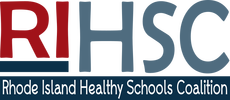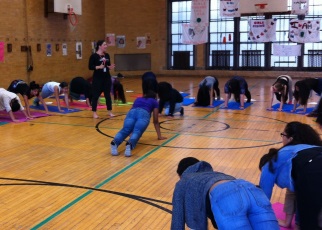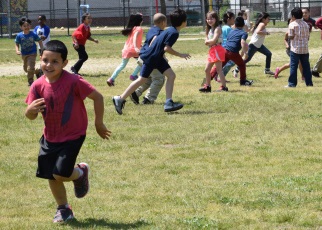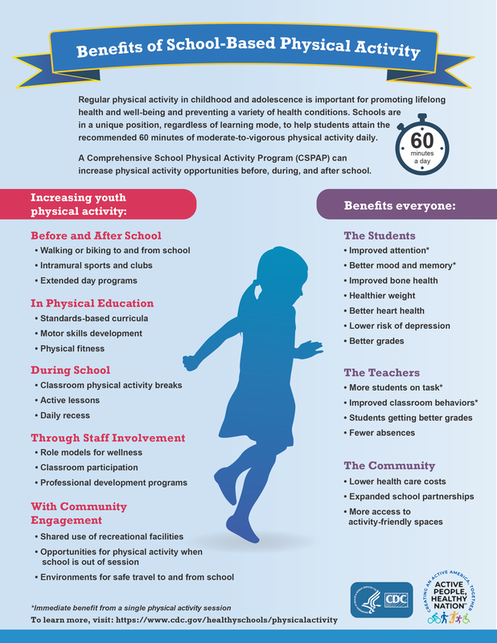Physical Education & physical Activity
|
Both PHYSICAL EDUCATION and opportunities for PHYSICAL ACTIVITY are important for the physical, cognitive and social emotional growth of all students. Research has proven Physical Education and physical activity breaks during the school day enhance student concentration, focus and successful learning while reducing behavior problems. Physical Education and physical activity promote student health and do not compromise academic learning. Click the image to the right for a helpful infographic from the CDC on the benefits of physical activities of all kinds in school! >>>>>>>>>>>
Benefits include:
|
|
PHYSICAL EDUCATION is.....
|
PHYSICAL ACTIVITY is.....
|
Physical Education
- SHAPE (website) Society of Health and Physical Educators has developed helpful tools for school administrators, principals and teachers to assist in the development of a quality Physical Education Program and the evaluation of a physical education program or class:
- RIAHPERD (website) RI Association of Health, PE, Recreation & Dance
- Active Schools (website) Includes on-line assessment & planning tools for school Physical Education and physical activity
- Presidential Youth Fitness Program website
- Rhode Island Physical Education Framework Framework for standards-based PE curriculum.
- Strengthen Physical Education in Schools (Springboard to Active Schools brief)
Physical Activity
- Physical Activity Guide for Parents 2018 (INFOGRAPHIC) (US Dept. of Health & Human Services)
- Physical Activity Guidelines for Americans (US Dept. of Health & Human Services)
- CSPAP (website) Comprehensive School Physical Activity Program is a multi-component approach by which schools use all opportunities for students to be:
- physically active before, during, and after school
- meet the nationally-recommended 60 minutes of physical activity each day
- and develop the knowledge, skills, and confidence to be physically active for a lifetime.
- Fuel Up to Play 60 (website) Fuel Up to Play 60 is an in-school nutrition and physical activity program launched by National Dairy Council and NFL, in collaboration with the USDA, to help encourage today's youth to lead healthier lives.
- RI Kids Count Obesity & Physical Activity (webpage) This page on the RI Kids Count website provides information about increasing physical activity in schools as a way to fight childhood obesity, including links to policy briefs they have produced on this topic, as well as links to other resources
- Involve School Staff in Promoting Physical Activity (Springboard to Active Schools brief)
Recess
- RI Recess Law
- Recess Rocks in RI - a Blue Cross & Blue Shield of Rhode Island/Playworks/RIHSC recess training initiative
- Keep Recess in Schools (Springboard to Active Schools brief)
- Painted Space Project (Eat Move Grow)
- Playworks website
- Peaceful Playgrounds website
- SHAPE America and CDC Strategies for Recess in Schools
- Alternatives to Withholding Recess
- Recess Aide Job Description - Westerly 2016/17
- Recess Aide Training - Westerly 2016/17
Classroom Activity Breaks
- CDC's Classroom Physical Activity page
- TeachHUB Strategies to Integrate Movement
- Five Movement Strategies in the High School Classroom
- Movement Strategies for Middle and High School Students
- 21 Ideas to Get Students Moving in the Elementary Classroom
- Active Academics website
- GoNoodle website
- Move to Learn website
- Fitness Breaks at School
- Energizing Brain Breaks
Before/After School Programs
- BOKS website
- BOKS Overview (pdf)
- BOKS Overview (pdf)
- Girls on the Run RI website
- Action for Healthy Kids Tip Sheet
Academic Research
- The Association Between School-Based Physical Activity, including Physical Education, and Academic Performance (US Dept. of Health and Human Services)
- Active Education: Growing Evidence on Physical Activity and Academic Performance Active Living Research
- Increasing Physical Activity Through Recess Active Living Research
- Supporting Quality Physical Education & Physical Activity in Schools Bridging the Gap Research Brief
- Supporting Recess in Elementary Schools Bridging the Gap Research Brief





